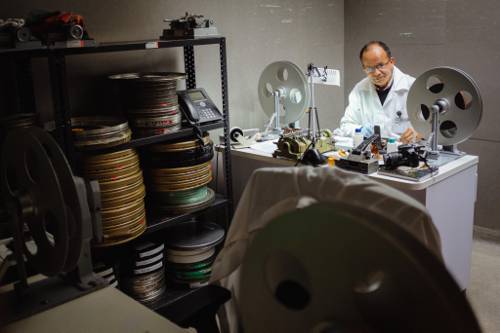
FAQ About The Role of Film Restoration in Preserving Cinema History

What is film restoration?
Film restoration is a process aimed at returning a film to a state that most closely resembles its original condition. This involves repairing damages, such as scratches or tears, correcting color fading, and restoring sound quality. Restoration can be applied to both the physical film strips and digital versions of the film.

Why is film restoration important for preserving cinema history?
Film restoration is vital for preserving cinema history because it prevents the deterioration of valuable films, ensuring that future generations can access and appreciate these cultural artifacts. Without restoration efforts, many classic films could be lost due to the fragile nature of aging film materials.

What are common challenges faced in film restoration?
Common challenges in film restoration include dealing with damaged or deteriorated film stock, color fading, missing frames, and sound degradation. Additionally, restoring a film often requires balancing historical authenticity with modern technical capabilities, which can be a complex and costly process.

How does digital technology impact film restoration?
Digital technology has revolutionized film restoration by providing powerful tools to repair and enhance films. Digital methods allow restorers to fix frame-by-frame damages, correct colors more accurately, and restore soundtracks to a higher fidelity. This technology makes it possible to preserve films that might be too fragile for traditional restoration techniques.

Are there different techniques used in film restoration?
Yes, film restoration employs a variety of techniques, including both physical and digital methods. Physical restoration might involve cleaning the film or splicing damaged sections. Digital restoration involves using software to correct visual and audio distortions, remove scratches, and enhance overall quality.

Who typically undertakes film restoration projects?
Film restoration projects are typically undertaken by specialized film archives, studios, and private companies dedicated to preserving film heritage. Prominent film institutions, such as the Criterion Collection, the British Film Institute, and The Film Foundation, are some of the major players in this field.

What role do film archives play in film restoration?
Film archives play a crucial role in film restoration by housing and maintaining the films that require restoration. They preserve the original materials, provide access to these resources for restoration experts, and often participate directly in the restoration process to ensure that films are kept for future viewing.

Can faded colors in old films be restored?
Yes, faded colors in old films can often be restored using digital color correction software. By referencing original color elements and historical documentation, restorers can often bring back the film's original visual aesthetics, though some artistic judgment may be required to accurately capture the intended look.

What is the significance of preserving digital archives in film restoration?
Preserving digital archives is significant because it ensures that films can be easily accessed and restored in the future, even if the original physical elements are lost or too damaged to use. Digital archives are less susceptible to physical decay and can be distributed widely, aiding in cultural preservation and accessibility.

How long can a film restoration project take?
The time required for a film restoration project varies widely based on the condition of the film, the complexity of the restoration needed, and the resources available. Some projects may take a few months, while others could span several years, particularly if the film requires extensive research and restoration work.

Is there a difference between remastering and restoration of films?
Yes, there is a difference between remastering and restoration. Remastering typically involves updating a film to improve its quality, often using original elements, to create a new master copy. Restoration, on the other hand, focuses on repairing and preserving the original film, aiming to return it to its original state.

How do restorers ensure accuracy when restoring historically important films?
Restorers ensure accuracy by conducting thorough research, consulting historical records, original scripts, production notes, and surviving copies of the film. Collaboration with filmmakers, historians, and archivists also helps to maintain fidelity to the film's original presentation and intent.

What are some famous examples of successfully restored films?
Some famous examples of successfully restored films include "The Godfather" series by Francis Ford Coppola, "Metropolis" by Fritz Lang, and "Lawrence of Arabia" by David Lean. These projects have received acclaim for their meticulous attention to detail and ability to showcase these classics to modern audiences.

Can silent films be restored, and how is it done?
Yes, silent films can be restored. This often involves repairing or re-creating intertitles, fixing damaged frames, and enhancing image quality using digital technology. Additionally, silent film restorations may involve creating new scores or restoring original soundtracks if available.

What role does funding play in film restoration?
Funding plays a crucial role in film restoration as it often involves significant costs related to the technical processes and labor required. Funding is typically sourced from film studios, government grants, cultural institutions, and charitable contributions, all of which help support restoration projects.

What is the process of restoring sound in old films like?
Restoring sound in old films involves digitizing the original audio tracks and using digital tools to clean up background noise, repair audio imperfections, and enhance clarity. This process sometimes also includes remastering the soundtrack to modern audio standards for better quality.

How can the public contribute to film restoration efforts?
The public can contribute to film restoration efforts by supporting organizations and initiatives dedicated to preserving cinematic history. This can include donations, advocating for funding, volunteering at film archives, or participating in film preservation events.

Are there ethical considerations in film restoration?
Yes, ethical considerations are crucial in film restoration, as restorers must balance preserving the original work with modern enhancements. Decisions on what to restore or alter involve careful deliberation to maintain the filmmaker's original intent and historical context.

What advancements have been made in film restoration techniques?
Recent advancements in film restoration include improvements in digital scanning, more precise color correction technologies, and algorithms for repairing damaged frames more accurately. These technological developments help restorers tackle previously insurmountable challenges in film restoration.

How do film restorers deal with missing footage?
When dealing with missing footage, restorers examine alternative sources such as other existing copies, production stills, and original shooting scripts to approximate what might have existed. In some cases, they may use placeholders or insert explanatory title cards to indicate the missing content to viewers.
